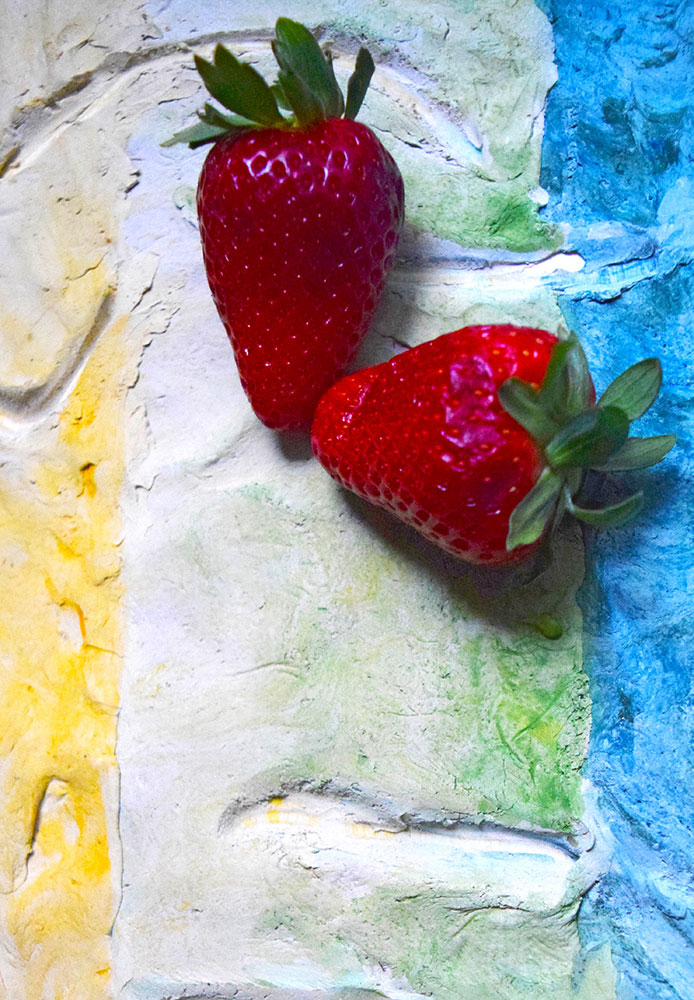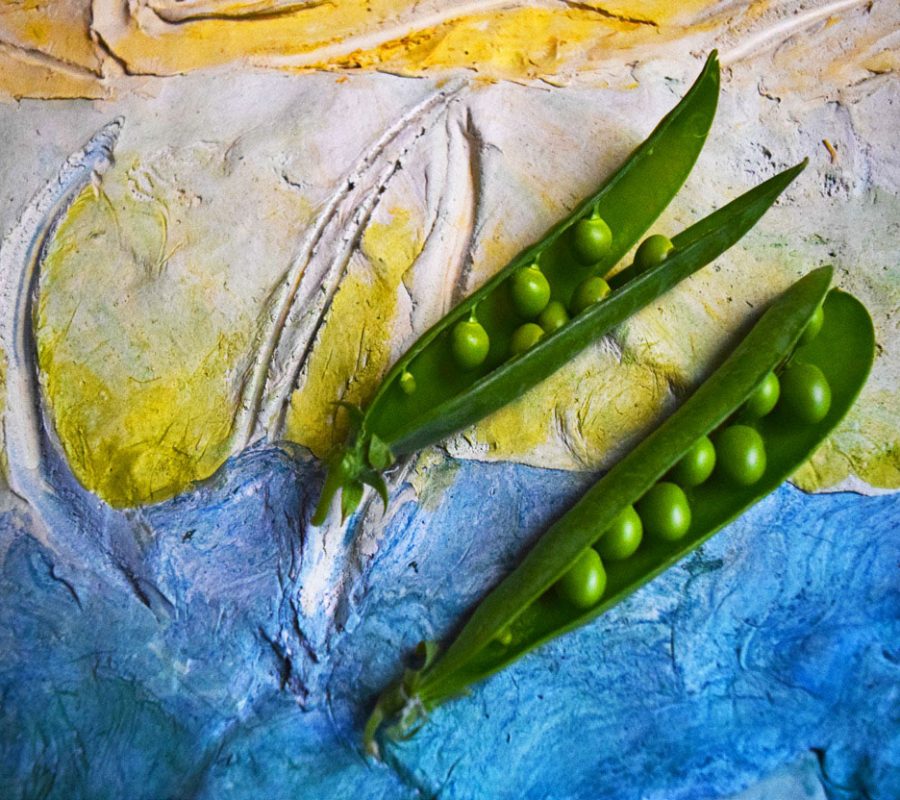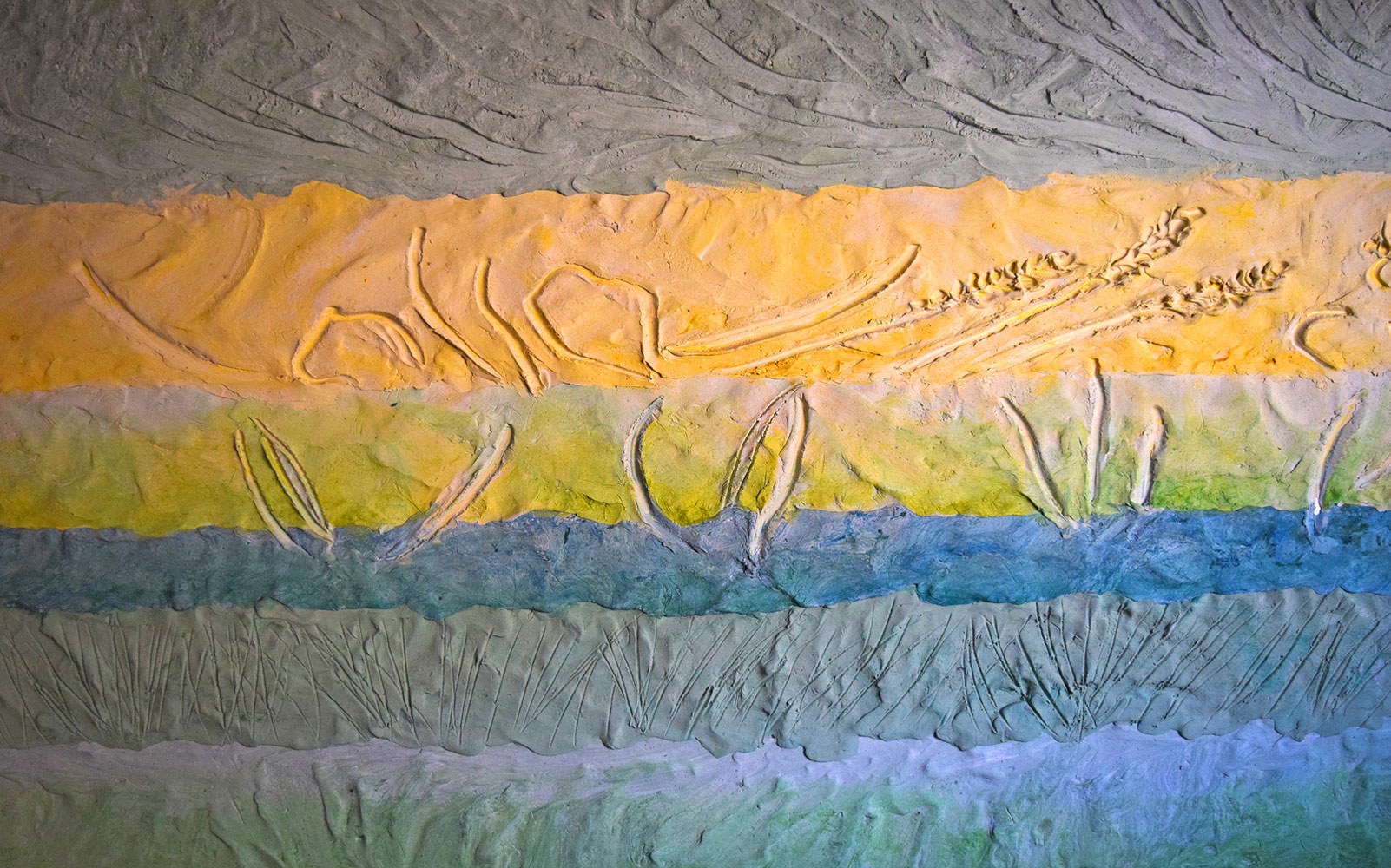PRI-
MA-
VERA
Spring is pungent on the Murgia and certainly not for the scented air that you breathe, but for a wild thorny plant much appreciated in the kitchen: u’ Cardungidde.

U’ Cardungidde – Scolymus Hispanicus – also called Cardoncello, not to be confused with the mushroom. This wild herbaceous plant that is part of the Murgia tradition has obtained the PAT designation. It grows in uncultivated lands and has the appearance of a thorny bush due to the prickles that it has on the perimeter of the leaves. It is collected in the early stages of growth, when it is still tender, before it gives birth to the beautiful yellow flowers. The wild herb collectors cut the rosette at the base, leaving the root in the ground and clean it while it is still in the meadows, freeing it from the prickly parts. The ribs that remain are cooked and are an excellent condiment for first courses, meats and cheeses. Like all wild plants, it has a high concentration of beneficial substances with purifying properties as they stimulate the liver to eliminate toxins from the body, improve digestion and help keep cholesterol under control.
Another prickly bush gives good fruit: Wild Asparagus – Asparagus Acutifolius. Light green in color, harvested tender, it is used for pasta preparations, omelettes and side dishes. The supply of nutrients is of high quality. It provides vitamin C equal to a third of the daily requirement of an adult, and folic acid in high percentage. Wild asparagus is also an excellent source of carotenes, which the body will transform into vitamin A, with antioxidant properties, protective of the skin and mucous membranes. Vitamin B2 is also present, necessary to transform food into energy.
Another prickly bush gives good fruit: Wild Asparagus – Asparagus Acutifolius. Light green in color, harvested tender, it is used for pasta preparations, omelettes and side dishes. The supply of nutrients is of high quality. It provides vitamin C equal to a third of the daily requirement of an adult, and folic acid in high percentage. Wild asparagus is also an excellent source of carotenes, which the body will transform into vitamin A, with antioxidant properties, protective of the skin and mucous membranes. Vitamin B2 is also present, necessary to transform food into energy.

Wild herbs are a treasure chest of infinite richness. The biodiversity of this territory in spring offers us a floral scene with delicate tones. Next to the yellow flower of Scolymus Hispanicus and Eruca Vesicaria – rocket – we find the pink-purple flower of Malva Silvestris and Rubus Ulmifolius – blackberry.
Edible plants with multiple properties. Even the animals that feed on the shoots know this well. Their milk contains the scents and properties of this vegetation. The figure of the shepherd is the one who passes on to us the loving care for the animals and the simple transformation of a few ingredients; milk, salt and rennet that become cheeses so different from each other, although the ingredients are always the same.
This is the surprising alchemy that we also find in the cheeses produced by the donnapaola company. Caciocavallo podolico, dairy products and more, enrich the taste of the table and the preparations in the kitchen. Tradition has it that ricotta is present in desserts but also in stuffed pasta dishes during celebrations, during lunches where the other main dish was lamb cooked with herbs.
Edible plants with multiple properties. Even the animals that feed on the shoots know this well. Their milk contains the scents and properties of this vegetation. The figure of the shepherd is the one who passes on to us the loving care for the animals and the simple transformation of a few ingredients; milk, salt and rennet that become cheeses so different from each other, although the ingredients are always the same.
This is the surprising alchemy that we also find in the cheeses produced by the donnapaola company. Caciocavallo podolico, dairy products and more, enrich the taste of the table and the preparations in the kitchen. Tradition has it that ricotta is present in desserts but also in stuffed pasta dishes during celebrations, during lunches where the other main dish was lamb cooked with herbs.
TRADITIONAL DISHES
THE SUNNY SEASON BRINGS WITH IT THE DESIRE FOR LIGHTER DISHES. VEGETABLE-BASED DRESSINGS ARE A CONSTANT IN TRADITIONAL CUISINE AND PRODUCTS FROM THE LAND ARE TRANSFORMED, WITH A FEW QUALITY INGREDIENTS, INTO EXCELLENT DISHES. TYPICAL VEGETABLES BECOME SIDE DISHES AND MORE.

SIDE DISHES
Cardoncelli arreganet (au gratin)
This wild plant, freed from its thorns, is boiled, placed in a terracotta pan and seasoned on the surface with a mixture of grated stale bread, parsley, salt, oil, cheese and put in the oven for gratinating. As an alternative to breadcrumbs, a mixture of eggs, cheese, parsley and oil can be used.Asparagus side dish
The asparagus harvested tender is blanched and put in a pan when the garlic begins to sizzle in the olive oil. Nothing else is needed, when the heat releases the smells of the ingredients, the dish is ready.New broad beans and chicory
Harvesting fresh broad beans allows for this fresh alternative to the puree of dried broad beans, as in other versions of broad beans with chicory. Boil the new broad beans and chicory, and serve them in a single dish with a generous amount of extra virgin olive oil.Mixed Leafy Greens
This dish features all the vegetables we can find in this season – chicory, chard, cardoon and wild herbs – cooked in salted water and then seasoned with a soffritto of oil, garlic, onion and the addition of a chili pepper. The vegetables seasoned in this way can also be served on a leavened or unleavened dough.FIRST DISHES
The first courses of fresh pasta, also mainly seasoned with vegetables, in some cases see the addition of cheese to enrich the flavor, as in the festive dishes, where the stuffed pasta became the extra touch. Some preparations…
Ricotta calzones
Once the fresh pasta sheet made with only semolina flour and water is rolled out, it is filled at intervals with a ricotta filling flavored with cinnamon. The whole thing is covered with another sheet of pasta, making it stick, and then the filled portions are cut, folding the edges over themselves – as is done in rustic calzones made with leavened dough. Once boiled in water, the calzones are seasoned with simple tomato sauce or with the addition of minced meat. The seasoning can be completed with a sprinkling of ricotta marzotica.Cavatelli with cardoncelli mushrooms
Homemade cavatello goes well with boiled cardoncelli mushrooms seasoned with a sauté of oil, garlic, onion and cherry tomatoes. A few sheets of caciocavallo cheese for stirring in the terracotta pan is an excellent variation. As an alternative to cardoncelli mushrooms, all the other wild herbs that the Murgia has to offer are fine.Vermicelli with wild asparagus
Long pasta like vermicelli or spaghetti, cooked with asparagus and seasoned with olive oil, garlic and cherry tomatoes, is a quick, simple and very tasty dish, so tasty that sprinkling with pecorino cheese becomes optional.SECOND COURSES
Lamb meat in the Murgia tradition is very present and mainly on feast days, as it is considered a precious good. Cooked in typical terracotta containers such as u pignatid, sealed with fresh clay or bread dough, to prevent the escape of odors and to better favor cooking on a wood fire. Even cooking on the grill, widely used, allowed to roast together with succulent meats, potatoes, onions, and good slices of homemade bread to be seasoned with oil and tomato.
Lamb cuttarid
Combine the lamb pieces and chopped vegetables in a pan: celery, carrot, potatoes. Season with olive oil, salt, rosemary and pecorino cheese in pieces. Cook with a little water and serve hot.Cazz brown – Brown
Large meat roll filled with chopped lamb offal, spicy salami, cheese or fresh provolone. Wrap everything up and tie it with casing, salt and bake in the oven with a drizzle of olive oil and bay leaves. Serve sliced with a side salad or in oil.Lamb Pignatta
Place pieces of lamb or sheep in a pignata, add a celery stalk, an onion, four or five tomatoes, a carrot, some chicory, pieces of spicy salami and pecorino cheese, a glass of water and olive oil. Close the pignata and seal it with fresh clay or bread dough. Cook for a couple of hours. Serve with a glass of red wine.Gnumariedd
Small rolls made from offal (liver, lung) wrapped in intestine and cooked on the grill or in the oven.OMELETTES
Omelettes were part of the daily life of a simple cuisine like the Murgian one, but they offered the possibility of enhancing the flavors of the herbs collected in the fields. Furthermore, the nutrients of the egg of the hen grown in the farmyard at home represented an inexpensive and very useful food to put on the table. Some preparations…
Ev du pov’ridd o du Priaterj
Cook in a terracotta pan, some onion with olive oil and a pinch of salt, add fresh tomatoes or tomato puree and let cook. At the end of cooking add the eggs placed on the surface, keeping the yolk intact and finish cooking.Potato omelette
Add slices of potatoes previously cooked in a pan with a little oil to the beaten eggs, cheese and salt. Pour everything into a hot pan with olive oil and cook. Serve hot or cold.Wild Asparagus Omelette
Combine raw asparagus with eggs, a handful of aged local cheese and a pinch of salt. Cook in a pan and serve hot or cold.Sponzali omelette
Cook the sponzali with a drizzle of olive oil and salt until they reduce in volume. Add to the beaten eggs, cheese, salt and pour into the pan for cooking. Serve hot and cold.SWEETS
Spring desserts almost have a hint of flowers. Cakes and baked goods with lemon essence inebriate the palate and the nose. Even for desserts, few and genuine ingredients, such as ricotta cheese for the filling of the cake. Flavored sugar to make the Giulebbe to cover the sweet taralli. Some preparations…
Ricotta Cake
Prepare the shortcrust pastry with flour, sugar, butter and eggs and let it rest. For the filling, mix the sheep ricotta with sugar, eggs, dark chocolate in small pieces, grated lemon peel and a pinch of cinnamon. Roll out the shortcrust pastry, fill it and cover it with crossed strips of pastry. Bake and serve cold.Sweet Taralli with Eggs
Mix flour, eggs, natural yeast, ethyl alcohol and olive oil. Work the dough well until it is smooth and shiny. Make some strings about twenty centimetres long and a couple of centimetres thick in diameter. Cut the strings lengthwise with a knife and close them in a circle. Bake in a very hot oven until the taralli have taken on a nice golden colour. They can be covered with a glaze or Giulebbe, obtained with beaten egg whites and sugar.Zeppole di San Giuseppe
The dough for the zeppole is made with flour and eggs, with the addition of a little sugar. The soft mixture is shaped into small donuts, using a pastry bag and fried in boiling oil. They will be garnished with custard and black cherries.Cream bites
Single-serving dessert made from sponge cake soaked in liqueur, custard and a touch of jam or black cherries in syrup.Scarcedda
Mix flour, natural yeast, olive oil, sugar. Once the dough is obtained, it will be shaped into baskets, dolls or horses. An egg with the whole shell should be added to the dough and fixed with pasta strings. Decorated with sugar flowers and aniseed, it should be cooked in the oven at a moderate temperature. It is a typical Easter dessert.EDIBLE HERBACEOUS SPECIES OF THE APULIA FLORA
PRESENT IN THE MURGIAN TERRITORY OF DONNAPAOLA
Biodiversity is one of the distinctive features of the donnapaola company. Its territory is rich in edible plants that have always accompanied the life of the populations of this land. Used for food and medicine, wild herbs represent a true heritage. Leaves, stems, roots and flowers, everything contributes to the recovery of good practices.
Below we offer you a list of plants used for the preparation of dishes.
Below we offer you a list of plants used for the preparation of dishes.
| NOME SCIENTIFICO | NOME VOLGARE | FAMIGLIA | PARTE EDULE |
|---|---|---|---|
| Anagallis arvensis L. | Centocchio dei campi | Primulacea | Foglia |
| Asparagus acutifolius L. | Asparago pungente | Liliaceae | Stelo |
| Asphodeline lutea L. Rchb. | Asfodelo giallo | Liliaceae | Stelo radice |
| Bellis perennis L. | Pratolina comune | Asteraceaea | Foglia fiore |
| Calamintha nepeta (L.) Savi | Mentuccia comune | Lamiaceaea | Foglia |
| Cichorium intybus L. | Cicoria comune | Asteraceaea | Foglia |
| Clinopodium vulgare L. subsp. | Clinopodio dei boschi | Laminaceaea | Foglia |
| Echium vulgare L. | Viperina azzurra | Boraginaceae | Foglia |
| Ferula communis L. | Ferula comune | Apiaceae | Stelo |
| Foeniculum vulgare Mill. | Finocchio comune | Apiaceae | Stelo infiorecsenza |
| Malva sylvestris L. | Malva selvatica | Malvaceae | Fiore |
| Marrubium vulgare | Marrubio comune | Lamiaceae | Stelo foglia |
| Nigella damascena L. | Damigella scapigliata | Ranuncolaceae | Foglia |
| Onobrychis caput-galli (L.) Lam. | Lupinella cresta di gallo | Fabaceae | Baccello fresco |
| Ornithogalum umbellatum L. | Latte di gallina comune | Liliaceae | Bulbo |
| Picris hieracioides L. | Asparagina comune | Asteraceae | Foglia |
| Portulaca oleracea L. subsp. | Porcellana comune | Portulacaceae | Foglia stelo |
| Reichardia picroides (L.) Roth | Grattalingua | Asteraceae | Foglia |
| Rubus ulmifolius Schott | Rovo comune | Rosaceae | Frutto seme |
| Salvia verbenaca L. | Salvia minore | Lamiaceae | Foglia |
| Sanguisorba minor Scop. | Salvastrella minore | Rosaceae | Foglia |
| Scolymus hispanicus L. subsp. | Cardogna comune | Asteraceae | Radice foglia |
| Scorpiurus muricatus L. | Erba lombrica comune | Fabaceae | Baccello fresco |
| Sedum rupestre L. subsp. | Borracina rupestre | Crassulacea | Stelo foglia |
| Sonchus oleraceus L. | Grespino comune | Asteraceae | Foglia |
| Tordylium apulum L. | Ombrellini Pugliesi | Apiaceae | Seme foglie |
| Tragopogon porrifolius L. | Barba di becco violetta | Asteraceae | Radice foglia stelo |
| Tribulus terrestris L. | Tribolo comune | Zigophylitaceae | Foglia stelo |
| Urospermum dalechampii (L.) | Boccione maggiore | Asteracea | Foglia |
| Vicia villosa Roth | Veccia pelosa | Fabaceae | Foglia stelo |
| Salvia verbenaca L. | Salvia minore | Lamiaceae | Foglia |
| Sanguisorba minor Scop. | Salvastrella minore | Rosaceae | Foglia |
| Scolymus hispanicus L. subsp. | Cardogna comune | Asteraceae | Radice foglia |



